#belarusian model
Explore tagged Tumblr posts
Text

Faina Bona via Amour Angels
#amour angels#faina bona#belarusian model#beautiful woman#beautiful face#cute face#great legs#outdoors#her smile#small body
28 notes
·
View notes
Text


Sasha Kichigina - Belarusian, 1998
#face claims#female face claims#female models#face claims central#beautiful girls#fan cast#character inspiration#fancast#models#wattpad#rp#rpg#rp oc#rp inspo#oc rp#belarusian#belarusian models#belarusian female models#european#eastern european#slavic models#slavic#eastern european models#white face claims#white female models#caucasian#caucasian models#caucasian female models#caucasian female face claims#white models
5 notes
·
View notes
Text










My favourite Belarusian Manchester Utd Football fan Kate Vaselinok ❤️ ❤️ ❤️
#sexy#beautiful#models#lingerie#beauty#lacy#long hair#see through#silky#Manchester Utd#Belarus#Belarusian Girl#London#Old Trafford#Kate Vaselinok
3 notes
·
View notes
Text

Belarusian swimmer in a potato field turned out to be a Polish model, 2018 - by Paweł Dejankiewicz, Polish
56 notes
·
View notes
Text
Just went through the depths ™ of my sketchbook and stuff ™. Pretty old stuff but it explains a lot of the lore of my version of Mondstadt. I know my handwriting is bad😭 I’ll try and translate
(You can see how different my style is on paper LMFAOOOO)
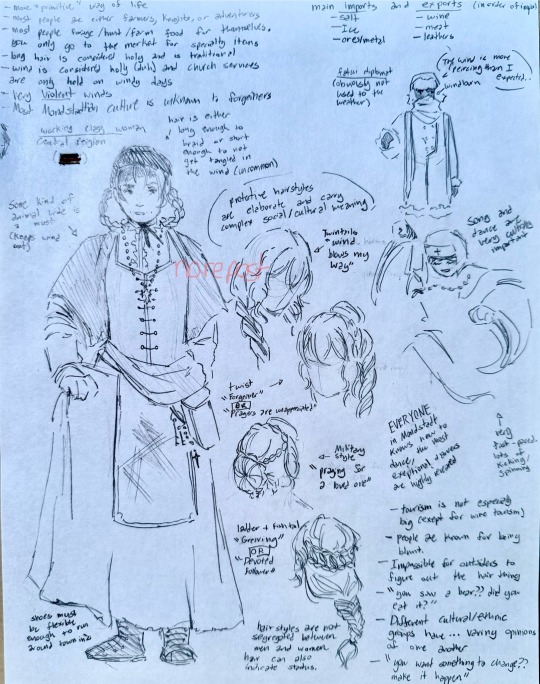
This one is the newest!!!
Wanted to elaborate on clothing and hair. I HATEHATEHATE how much traditional German clothing is sexualized so guess what I did!!!! Anyway I wanted to lean further into traditional German clothing while also taking into account what would be most convenient for the people living there. I wanted hair to be super important too. MONDSTADT IS WINDY. WHY IS YOUR HAIR DOWN PEOPLE. So I thought since people generally have their hair up here they would probably develop a really complex culture around the way hair is put up. (Thank u kaeya and diluc for being my hair models) And Since wind is considered holy there would probably be religious implications there too.
I also think it would be kinda neat if other nations were kinda unbeknownst to the fact that mondstadt has culture aside from drinking.

WHEW THIS ONES OLD. I wanted to go more in depth about the internal relationships between the cultures of mondstadt. I had noticed the cross symbol around and kinda tried to recontextualize it to fit the world.
Here’s a transcript of some of the bottom text for those who can’t read it:
“Those who hail from the south (east AND west) are generally looked down upon by those who are from central/northern mondstadt. They are seen as trashy/dangerous due to association with the fatui.”
“Southwestern ethnic/cultural groups include:
- Czechs/Slovakians (usually just referred to as Czechoslovakians, there’s no real reason to separate in this context)
- Hungarians
- Croatians
- Albanians
Southeastern ethnic/cultural groups include:
- Poles
- Lithuanians
- Belarusians
- Romanians”
If any explanation is needed just let me know!! These are very old haha
In any case here’s some assorted brainrot notes:
Inazuma has closed its borders completely, disallowing the majority of trade and travelers. However, a select few people are allowed within the country’s borders for trade/political talks.
Inazuman salt is essential to the survival of the people of mondstadt, as they need it to preserve their meat for winter.
Many nations, ESPECIALLY FONTAINE, look down upon mondstadt, because they see it as a trashy, uncivilized place full of drunkards.
#genshin diluc#diluc ragnvindr#diluc#genshin fanart#my art#ragbros#genshin comic#genshin impact#genshin kaeya#kaeya alberich#gi#jean gunnhildr#jean genshin impact#Jean genshin#kaeya ragnvindr#ragfam#mondstadt
67 notes
·
View notes
Text

Belarusian model Alexandra Danilova
22 notes
·
View notes
Text
🟨WEDNESDAY morning - events from Israel
ISRAEL REALTIME - Connecting to Israel in Realtime
▪️4 HERO SOLDIERS HAVE FALLEN.. in battle in Gaza, in an exploding building…
Daniel Simon Toaff, 23, from Moreshet
Agam Naim, 20, from Mishmerut - the first female soldier to fall in combat in Gaza
Amit Bari, 21, from Yoshaviya
Dotan Shimon, 21, from Elazar
May their families be comforted among the mourners of Zion and Jerusalem, and may G-d avenge their blood!
▪️UN SECRETARY GENERAL.. developments in Lebanon are extremely worrying, especially considering the fact that there is an area of "extreme instability". Regrets the civilian deaths in Lebanon. (( You can tell they are civilians because they are dressed in regular clothes while carrying secure encrypted communication devices of the Hezbollah terrorist army. ))
▪️RED ON RED - JENIN.. Clashes between civilians and Palestinian Authority security in Dan, near Jenin, due to an attempt to neutralize explosive devices.
▪️BEEPER BOMBS - A BIT OF INFO AND ANALYSIS..
.. A few people asked, what’s a beeper? Also known as a pager. A small cell-phone sized device that simply receives text messages and makes alert sounds. More advanced ones allowing sending of messages as well. Commonly used by doctors in the U.S. No longer in use in most professions. Think of it like a tiny phone that just does SMS.
.. Analysis: The main damage caused to Hezbollah is damage to its operating model. Hezbollah is built on a rapid transition from routine to emergency. The system is built on these pagers.
.. New York Times: Imported from Taiwan and treated before arriving in Lebanon. The terrorists received messages as if from Hezbollah leadership.
▪️PENTAGON SAYS.. The Pentagon: The best way to reduce tensions on the Lebanese border is diplomacy.
▪️IRAN SAYS.. Genocide !!!!!!!! !!!!! !!!!! !! !
▪️US PRESIDENTIAL CANDIDATE HARRIS SAYS.. Kamala Harris, in response to a question asked at the conference about the war in Gaza, says that she supports delaying shipments of one-ton bombs to Israel.
▪️COALITION POLITICS.. with news that Sa’ar would possibly enter the coalition and become Defense Minister, leaks now say Israel our Home MK Lieberman is considering entering the coalition. MK Lieberman is very right wing on defense and security issues, and very left wing on religious-state issues.
▪️HOLOCAUST JEWISH MASS GRAVE DISCOVERED.. 11 children ages 1-7 and 12 adults - Belarusian authorities located a newly-found Jewish mass grave containing 23 bodies in the town of Strashin in the country's Homel district. The town of Strashin was occupied by the Nazi German army in August 1941.
🔹HEZBOLLAH LEADER NASRALLAH.. will speak Thursday at 17:00 about the latest developments.
♦️JORDAN - “We shot down a UAV that entered our airspace heading towards Israel.” (Likely from Iraq headed towards Israel.)
♦️SAMARIA - SHECHEM.. overnight report on clashes and shooting in Shechem between the security forces and locals.
⭕HEZBOLLAH SUICIDE DRONES.. attack TIBERIUS area: Ginosar, Wadi Hamam, Livnim, Migdal, Tiberias, Arbel overnight. Intercepted.
⭕2 ROCKET ATTACKS, 2 SUICIDE DRONE ATTACKS overnight from HEZBOLLAH.
⭕OFFSHORE SUICIDE DRONE from HEZBOLLAH fired at Nahariya, intercepted.
⭕INFILTRATION - BEITAR ILLIT.. overnight report of security fence crossing, residents required to barricade. Incident cleared.
✡️A brief daily word of Torah: "The pure righteous do not complain of the dark, but increase the light; they do not complain of evil, but increase justice; they do not complain of heresy, but increase faith; they do not complain of ignorance, but increase wisdom." ~ Rabbi Abraham Isaac Kook
#Israel#October 7#HamasMassacre#Israel/HamasWar#IDF#Gaza#Palestinians#Realtime Israel#Hezbollah#Lebanon
26 notes
·
View notes
Text









WMAF couple # 71 - Belarusian 🇧🇾 and Chinese 🇨🇳
Pavel, also known as "Pasha" is a model based in Shanghai and Nina Cai is a dancer. They've been together for 2 years
#wmaf#white male asian female#interracial#interracial couple#interracial love#international couple#afwm#wmaw#awwm#international love#white guys asian girls#white guy#asian girl#belarusian#belarusian guy#chinese#chinese girl#couple#couple love#couple goals#mixed couple#外国男友#belarusian chinese#chinese belarusian#🇧🇾🇨🇳#🇨🇳🇧🇾
7 notes
·
View notes
Text

Matty via Femjoy
#femjoy#ora#matty#belarusian model#beautiful woman#beautiful women#beautiful face#cute face#cute woman#small body
20 notes
·
View notes
Text
Gods of ancient slavs: Perun and his imaginary friends
Let's deal with what gods in Ancient Rus' were, and what were not.

The gods of pagan nations are a rich and interesting topic. Their images, in some ways unique, and in some ways similar in different nations, inspire many modern authors. Including in the genres of fantasy, sci-fi, and magic realism.
Back in the 19th century, attempts were made throughout Europe to reconstruct ancient beliefs and understand what gods were worshipped by ancestors. And, of course, the myths of ancient Greece were taken as a model.
The only thing is that we were usually talking about non-written cultures, which left behind very few sources. And if the Scandinavians, for example, had the Eddas, written down already by Christians, but quite early, as well as inscriptions carved in stone, then with the Eastern Slavs everything did not work out so well. We have no recorded epic stories about the gods, and we have to rely on fragmentary evidence in chronicles and denunciations against the pagans, as well as scanty archaeological data. That is why there is so much speculation and outright fiction about the gods of the Eastern Slavs.
In this text, let's try to figure out what we really know about them, what we can assume, and what is quite far from the truth.
The Pantheon of Knyaz Vladimir
The most famous source of information about the gods worshipped in Ancient Rus is the enumeration of idols installed by Knyaz Vladimir in Kyiv, from the "Tale of Bygone Years":
"And began to reign Vladimir in Kyiv alone, and put idols on the hill, outside the palace yard: wooden Perun with a silver head and golden whiskers, Khors (and) Dazhbog, Stribog, Simargl and Mokosh."

Vladimir puts idols of gods in Kyiv. Late 15th c. Radziwillov Chronicle, Library of the Academy of Sciences, St. Petersburg
It should be kept in mind that Vladimir pursued quite specific goals: he tried to unite Rus around Kyiv through a single set of beliefs. That is, it would be wrong to say that the erected idols are an exhaustive list of gods or that all popular gods got there. For example, we are talking, apparently, about Slavic gods, and on the territory of ancient Rus lived also Finno-Ugrians, Turks, Balts.
In addition, it is important to understand that any paganism (even Greek) at the level of practice looks not as the veneration of a once and for all definite pantheon, but as the worship of numerous local deities - patrons of rivers, hills, forests, cities. People turned to them for any reason: for good luck in war, for a rich harvest, and for protection from evil forces. Different gods could merge in one area, and in another, on the contrary, one god was divided into two characters or more.
We do not know on what principle idols were selected in Kyiv. For example, Veles (Volos), often found in other sources, is not mentioned among them. In addition, the "Tale of Bygone Years" was preserved in lists XIV-XVI, not in the original, and the lists were often made with errors. And Nestor did not aim to accurately convey the pagan ideas. But we have what we have - there is nothing to choose from.
So what do we know about the 5 (or 6) gods mentioned in the Tale?
Perun
We know relatively much about Perun. He is often mentioned in various sources, he was worshipped by the Western Slavs, about whose customs we know a little more. He is also close to the Baltic Perkunas, and many of his features and related legends were attributed to Ilya the Prophet and remained in this form until the Revolution.
Perun is a thunder god. The very word "Perun" in Russian, Ukrainian and Belarusian is used as an obsolete and poetic name for lightning. This was an important god for the inhabitants of Ancient Rus, commonly known and honored. He may well be considered the supreme god, if it is necessary to emphasize such a figure. The Byzantine Procopius of Caesarea wrote back in the 6th century that the Slavs (it was about the South Slavs) above all venerate an unnamed thunder god to whom they sacrifice bulls. The connection of Perun with warriors and militancy, oaks, weapons - all this is characteristic of the gods-thunderers - looks quite plausible.
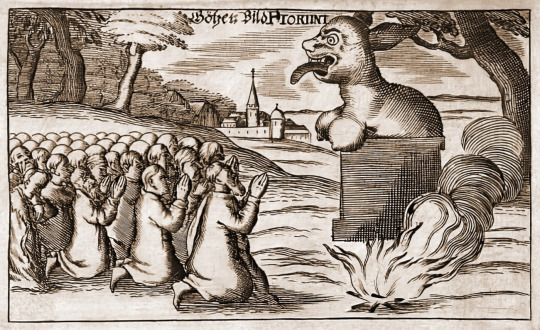
Worship of Perun among the Muscovites. Engraving from the book by G. A. Shleizing "Ancient and New Religion of the Muscovites", 1698
Later sources mention rituals in honor of Perun. For example, Novgorod fights were described, which were associated with the commemoration of Perun. There is also a mention of the rafting of Perun's idol down the river, similar to the description of the overthrow of his idol from the Tale of Bygone Years. Some researchers suggest that the chroniclers simply incorrectly conveyed the regular ritual. The motif of such funeral-conductions is rarely associated with thunder gods, it is more characteristic of the gods of the sun and fertility. This may mean that Perun had such functions as well.
Various assumptions about Perun's family ties, specific features of his veneration, sacrifices, temple construction, etc. should be treated with caution: they are based on controversial scientific data.
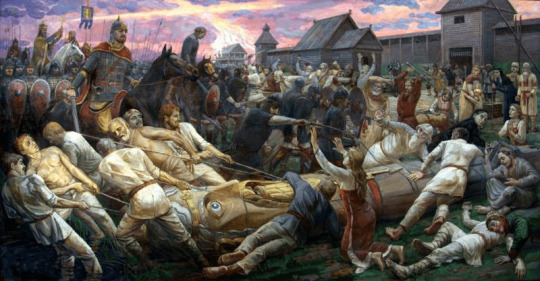
The overthrow of the idol of Perun in the painting "The Trampling of Old Russian Gods" by E. Shtyrov
But one can look at the peculiarities of popular veneration of the "formidable saint" Elijah the Prophet. His image began to converge with Perun even before the official baptism of Russia, as pagan and Christian legends converged (such a merger is more than characteristic of the pagan picture of the world). Most likely, this is what made Ilya one of the most revered saints in Rus'.
It was believed that the prophet rode across the sky on a golden or fiery chariot and struck devils and various creeps with lightning arrows. In some regions it was believed that Elijah should pray in a thunderstorm all the time, so that a demon would not enter a person, because then the prophet would strike him with lightning. Caution should be observed on Ilya's day at the end of the harvest (August 20): on this day it was forbidden to work in order not to anger the saint. In addition to striking devils and people with lightning, Ilya also sent down rain and drought. These legends about the saint probably go back to the image of Perun.
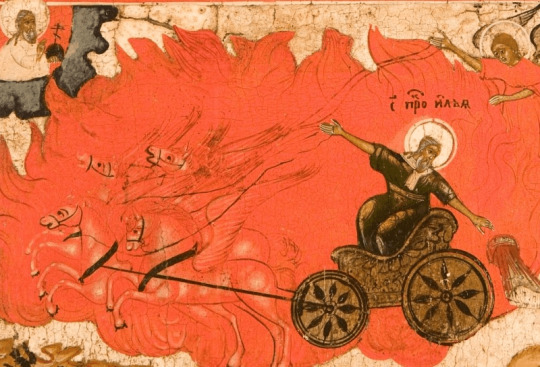
Elijah the Prophet on his chariot
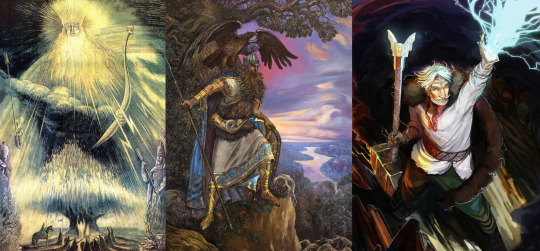
Various Peruns by lugvelesasrz, A. Klimenko, Mikado13
Mokosh-Makosh

Makosh by Viktor Korolkov
Mokosh is the only female goddess in Knyaz Vladimir's pantheon.
The romanticist researchers largely invented her cult from the folk veneration of St. Paraskeva Pyatnitsa, associated with weaving and needlework. From weaving made the transition to the threads of life, and Mokosh turned into the goddess of fate. The problem is that unlike Perun and the prophet Elijah, we do not know anything about Mokosh at all, except that she was a woman. For example, we have no data that she was depicted with a spinning wheel. So there is simply nothing to draw parallels between her and Paraskeva.
Sometimes the figure of Mokosha is brought closer to such a folklore character as Mother raw earth. This is a common image in bylinas and fairy tales, and we can conclude that in the Slavs' ideas the earth occupied a very important place. But it is hardly worth talking about the personification of the earth in the form of a goddess. Most likely, the earth as a living element was meant, which reminds ancient religious ideas, for example, the Chinese. However, it is possible to correlate Mokosh with Mother raw earth. This is much less of a stretch than many other theories about the Slavic gods.
Who else could be the only goddess included in the new unified pantheon? For example, the goddess of women, patroness of childbearing and women's crafts. Or the goddess of fertility, possibly acting as wife of Perun. Or maybe a warrior goddess like Ishtar, the embodiment of power and luck in battle. Such a woman could well be on the princely hill, where, judging by the "Tale" did not take the "cattle god" Volos, despite his great importance. Historical data in no way limit the flight of our imagination.

Mokosh by BirnaAlicja
Khors-Dazhbog
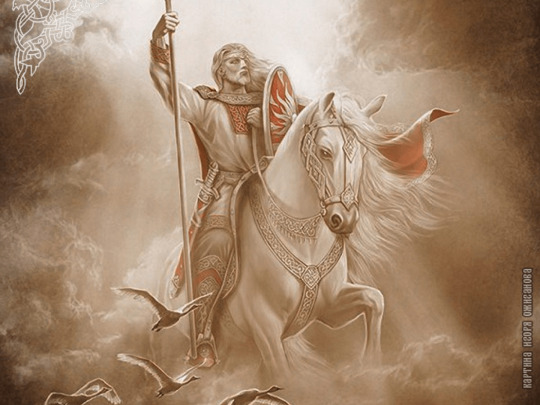
Khors by Igor Ozheganov
The further things are worse. Between the names of Khors and Dazhbog in the "Tale" there is no union, but between the other names there is. This may be a reproduced mistake of the scribe. Or it may be an indication that these are two names of the same god (Khors-Dazhbog). In other sources both gods appear separately, but are never mentioned together.
In the "Conversation of the three saints" there is such an answer to the question where lightning comes from: "There are two thunder angels: the Hellenic elder Perun and Khors the Jew - these are the two angels of lightning". What it means and why these national epithets - who can tell. Some researchers believe that this is an indication that the cult of Khors came to Russia from the Jewish Khazaria, but this is a controversial statement.

Khors by Andrey Shishkin
There are also questions with lightning. This is the only mention of Khors with its functions. But there is a popular theory about the etymological connection of Khors with the Iranian-language root "khur", "khvar", meaning "sun". Linguists dispute this point of view, but so far it remains dominant, and the idea of connection of Khors with lightning, which does not fit into this concept, is often rejected.
In the "Tale of Igor's Campaign" there is an ambiguous phrase: "in the night trotting wolf: from Kyiv to Tmutorokan kurs, to the great Hrsovi the way was broken". Interpreting "Hrsovi" as "Khorosovu", romantically inclined researchers conclude that the "Khors' way" and consisted in "trotting wolf". And so Khors was actually connected with wolves, werewolfism and acted as a dark god of wild beasts and witchcraft. But it should be remembered that the only direct indication of Khors' functions is connected with lightning, and in the "Tale" it is quite possible that he was not meant at all.
In short, the god Khors was, but what he was doing - we will never know.
And what about Dazhbog? Let's see what Wikipedia calls the most informative source about him - "Chronography" by the Byzantine John Malala. He wrote, however, about the Egyptians, and the name Dazhbog was used to translate the name of the sun god Helios mentioned there, which in turn symbolized Amon Ra. From this we can conclude with some tension that the translator associated Dazhbog with the sun god. Also the word "Dazhbog" is mentioned in Ukrainian songs, including as the one who ends winter and begins summer. This also confirms the solar version.
In "The Tale of Igor's Campaign" knyazs or all Rus' people are called "Dazhbog's grandsons". Although there are different opinions about what this means, perhaps it is about the fact that Dazhbog was perceived as the forefather, the god-grandfather of the nation or humans in general.

Dazhbog by Andrey Shishkin
Stribog
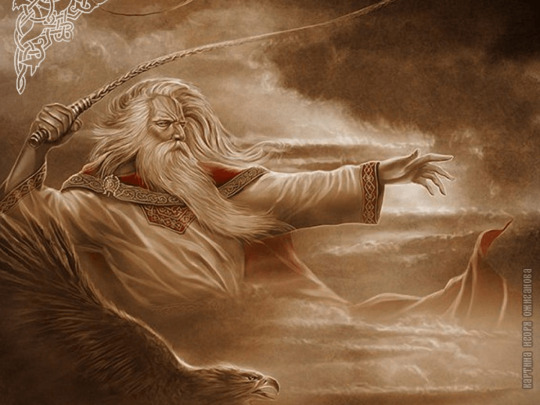
Stribog by Igor Ozheganov
Stribog is another character about whom we know nothing. Practically the only mention - in "The Tale of Igor's Campaign" it is said about the winds as "Stribog's grandsons", who direct arrows against Igor's army. On the basis of this not even a passage, but a sentence, theories were built that Stribog is the god of winds, as well as an evil god, an opponent of men, who was opposed to Dazhbog (mainly because both words are arranged in the same way).
From here went the identification of Stribog with St. Kasyan - a very curious character of folk Orthodoxy, evil, hostile, crooked (oblique) in one eye, guarding hell and sending winds and diseases. Kasyan deserves a separate story, but the grounds for his correlation with Stribog are very shaky.
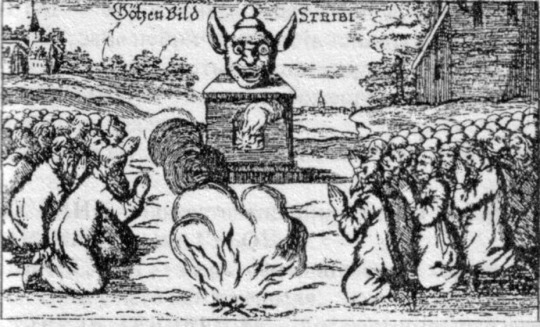
Worship of Stribog at the Muscovites. Engraving from the book by G. A. Shleizing "Ancient and New Religion of the Muscovites", 1698
Simargl

Semargl by V. Korolkov
And the most mysterious character of Vladimir's pantheon is Simargl. In the "Word of a certain Christ-lover and zealous for the right faith" there is a quote: "believe… in Sim and in Rjgl (Erjgl)". But in other manuscripts Simargl or Semargl is written in one word. Who this person or persons were, what they did, is unknown. At some point his name was correlated with the Iranian Simurg on the basis of the similarity of the words. Simurgh is a mythical king-bird whose image probably (probably!) derived from Senmurv, a half-bird half-dog. The odious researcher Rybakov suggested that it was the half-bird-half-dog that stood on the hill in Kyiv, that he was the messenger of the gods, and was also associated with fertility and much more. All this does not stand up to criticism from a scientific point of view.
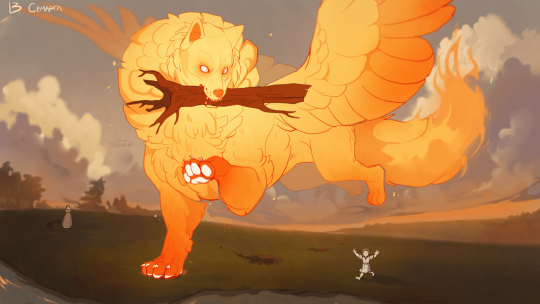
Simargl by Irdeorum-III
Who wasn't taken to the hill?
Volos / Veles
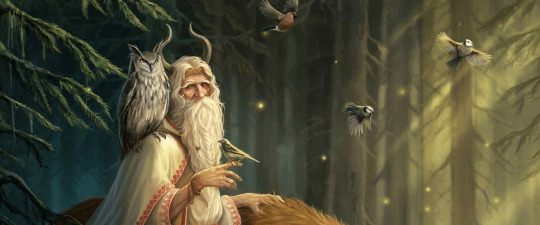
Veles by baklaher
Volos, judging by frequent references in sources, was a popular god of Ancient Rus. His name was sworn along with the name of Perun. He is often called the "cattle god", i.e. the patron of cattle, and therefore of wealth. That is, we even know what functions he had.
"The Tale of Bygone Years" does not mention Volos among the idols of Knyaz Vladimir's "pantheon". Much later "Kyiv Synopsis" mentions, but there and all the rest of the list differs, except for Perun. And in "The Life of Vladimir" it is said that the idol of Volos was thrown into the river, where in the "Tale" the idol of Perun was thrown. And here it is not clear: the idol of Volos was, but stood separately, as some researchers claim - for example, at the market? Or stood together with all, and Nestor did not mention it? Or some of the gods described by him is actually Volos?
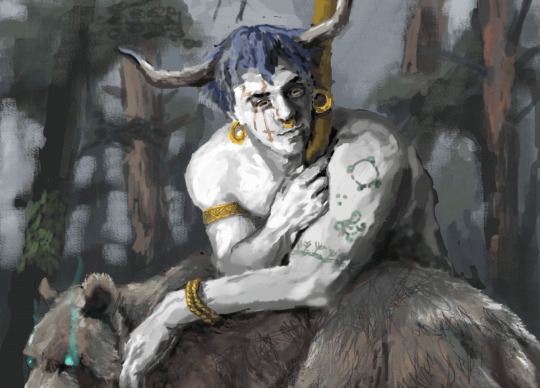
Veles by Milica Cvetic
All information about Volos besides the fact that it was an important god of cattle looks extremely shaky. There is a theory that he was an opponent of Perun. It is based on the correlation of Volos with the Baltic Vels and Velnyas, a spirit connected with the underworld and cattle, and the opponent of Perkunas the thunderer. However, it should be realized that the sources telling already about this character are rather late and of ambiguous authenticity.
When contrasting Volos and Perun, it is sometimes said that Volos was the earthly god of gold and the common people (apparently, farmers), and Perun was the heavenly god of war and the rulers' retinue. This idea is based largely on the text of the oath, which mentions both Perun and Volos, as well as gold and weapons: "let us be cursed by the God in whom we believe, Perun and Volos, the cattle god, let us be as yellow as gold, and let us be cut with our weapons".
But, first, there is no obvious distinction here. Secondly, gold is mentioned in the context of yellowing of the skin and speaks rather of disease. It would be more accurate to conclude that these were powerful gods ruling over life and death. Hair was indeed most likely associated with wealth, but expressed primarily in livestock . And the possession of wealth is not very peculiar to the "common people" who are usually poor.
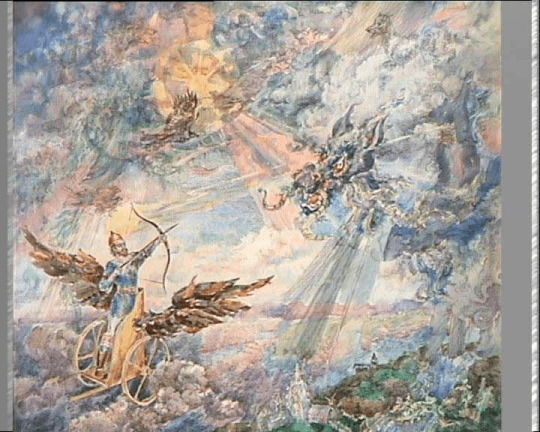
Perun fights with the serpent by A. Fantalov
The further development of the idea of the enmity between Perun and Volos turned him into a serpent, because the motif of the battle between the thunderer and the serpent is archetypal and is found in many peoples. The opposition of heavenly birds with earthly snakes, "creepers", in the culture of the Eastern Slavs occupies a very important place. But there is no reason to believe that it goes back to Volos.
"The Tale of Igor's Campaign" contains an indirect reference to Volos. Bayan, the legendary narrator, is called Veles' grandson. This can be understood as an epithet referring to his gift of words. And on this basis Veles is sometimes considered the god of poetry.

Veles by A. Klimenko
A more creative interpretation says that it refers to the gift of sorcery or volkhovanie. The idea of Veles as a god of wisdom, as well as many of his other attributes, entered popular culture from the "Book of Veles", a forgery from the 50s of the 20th century. For sure we can only say that there was such an important god Volos, and he had power over cattle, and thus welfare.

Veles by Andrey Shishkin
Svarog and Svarozhich
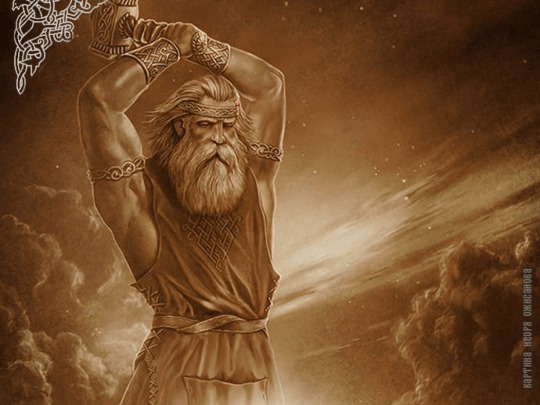
Svarog by Igor Ozheganov
Svarog is mentioned in the "Tale of Bygone Years", in the above described "Chronography" of John Malala. There, I remind, we are talking about the Egyptians, and the word "Svarog" is used to translate the name of Hephaestus (which is called, apparently, Khnum). Other sources mention Svarozhich, and it is probably the same character. Svarozhich was honored by the Western Slavs and was associated with fire. Whether he was honored in Ancient Rus is unknown.
Even if he was, a fire god is not always the same as a smith god, as Svarog is usually represented in popular culture. A fire god can be a god of hearth and sacrifice, a mediator between gods and humans, like the Indian Agni.
All others
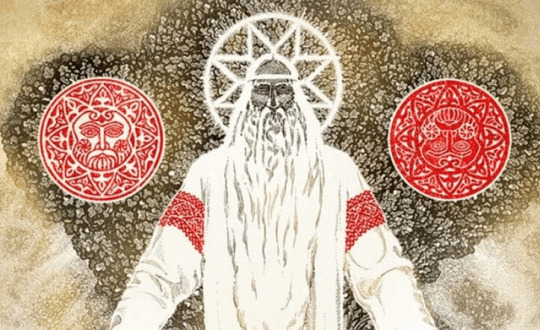
Rod by Maxim Kuleshov
For example, Trojan is the demonized emperor Trajan. His image is found in the folklore of the South Slavs, but it is more of a fairy-tale character. In "The Tale of Igor's Campaign" Trojan is also present, but there it is said about "time" or "trope" of Trojan, so it is not very clear whether it is about some ancient ruler-man, mythological character or deity, or whether there is some mistake of the copyist or translator.
It is also known as Dyj or Diy. Sometimes it is mentioned among the gods worshipped by pagans, but more often it is used to translate the name of Zeus in the retelling of ancient myths.
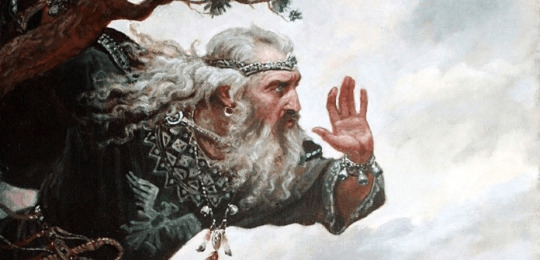
Pozvizd by Andrey Shishkin
Rod and the Rozhanitsy are not infrequently mentioned. But usually in the same lists, where in addition to gods it is said about the worship of vilas, ghouls, bereginas. Which, undoubtedly, were important characters in Slavic folklore, but they are rarely called gods, singling them out as a separate category (like nymphs, alves and other spirits). How far this is actually legitimate - the question is debatable, but this is the tradition. And it is quite possible that under Rod and Rozhanitsy meant the worship of ancestors and patron spirits.
The "Kyiv Synopsis", compiled very late, in the 17th century, gives an alternative list of idols erected by Vladimir. In addition to Perun, called the god of thunder and rain in human form, Volos, the god of cattle, as well as Pozvizd, Lado and Kupalo are mentioned.
All of them are associated with the book tradition: the authors of later sources, in imitation of the Greeks, invented gods themselves and then copied them from each other. Sometimes they relied on parallels with the same ancient mythology, sometimes - on grassroots folklore, folk rituals and festivals. And when odious researchers began to study such sources, Lado or Uslad, appearing in several later sources in the male gender, turned into the goddess Lada. That is, here we see layers and layers of fiction.
To such a mythology invented by scribes belong also Lel, Lelya and Polelya. The last three are chants like "la-la-la-la-la" deified in a desperate attempt to find some pagan gods.
Marena was hardly a goddess either, no matter how attractive her image in popular culture as a strong woman who commands winter and death. In fact, she is a ritual character, an effigy or tree burned when winter is spent, like Maslenitsa - or ritually mourned in later spring, like Kostroma. The latter connects it with the death-rebirth cycle: it is a metaphor for the sowing of seeds into the ground ("funeral") and their subsequent germination ("rebirth").
The second reason for the appearance of the image of the goddess of death is the similarity of the name Marena to the Latin root mor: "death", i.e. the fact that Christian authors and early researchers were engaged in folk etymology (this is when words are attributed a similar meaning because they sound similar, a headache for any linguist). But of course, the gothic ice maiden is beautiful.
Another popular image popularized by Gaiman's American Gods is Chernobog, the malevolent god of evil. The character is also very spectacular, moreover, most likely, really former god. It is described, however, in the Baltic Slavs, but in Russia and Ukraine there are toponyms referring to this name. We do not know much about him, except that because of the ominous name of Chernobog very much loved Christian authors, boldly writing him in the devils.
Often he is mentioned together with Belobog, his antagonist and embodiment of good. But in recent times, the opposition between Chernobog and Belobog has been attributed to the fantasy of authors impressed by Manichaeism (a dualistic religion that asserted that evil and good were equally powerful).
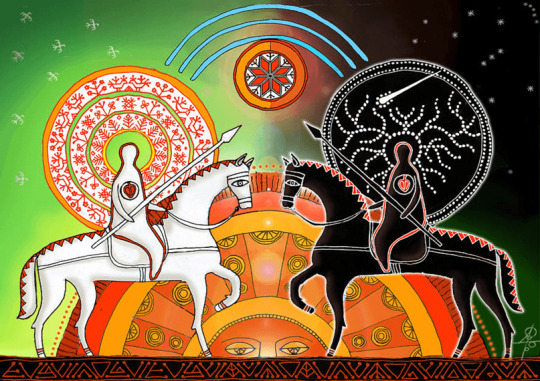
Chernobog and Belobog by Maxim Shukharev
As for Chernobog himself, if he was not invented by Christian authors, it is not a fact that he was such a villain. Black color does not always mean something bad, it can be associated, for example, with black soil - fertile land. It is not excluded that the black god could be called different characters depending on the area or specific idols made of black stone or wood.
Of course, it is a pity that we are not left with at least our own Edda to learn more about the gods worshipped by the Slavs in the territory of Ancient Rus. But this is not a unique situation - in many countries, ideas about the pagan past are also based on romantic speculations, controversial etymological constructions and Christian or Roman sources.
And if you want to learn more about mythological representations of Russians, Belarusians and Ukrainians - turn to the rich grassroots folklore, folk orthodoxy, fairy tales and songs. There you can find a lot of beautiful and interesting characters, images and themes that are undeservedly overlooked in attempts to find gods like those of the ancient Greeks.
Original by Maria Solntseva Translated by me :)
#slavic#slavic culture#slavic folklore#slavic folk#slavic mythology#folk#folklore#slavs#history#culture#history tag#mythology and folklore#mythology#slavic polytheism#slavic paganism#paganism#pagan#paganblr#diety work#ancient history#ancient rus#human history#polytheism#cultural history
27 notes
·
View notes
Text


Zhenya Katava - Belarusian, 1994
#face claims#female face claims#face claims central#belarusian#belarusian models#european#eastern european models#wattpad#fancast#fan cast#female models#beautiful girls#character inspiration#models#eastern european#white models#white female face claims#brunette
1 note
·
View note
Text










More beautiful Kate Vaselinok pictures. My favourite Belarusian. And she supports Man Utd. What more could a man want.
2 notes
·
View notes
Text

Belarusian swimmer in a potato field turned out to be a Polish model, 2018 - by Paweł Dejankiewicz, Polish
92 notes
·
View notes
Text
Wickenheiser, Virtue among 42 former Canadian Olympians banned from entering Russia
333 total Canadians banned in response to sanctions imposed by federal government
April 12, 2023
Hayley Wickenheiser, Tessa Virtue and Clara Hughes are among dozens of former Canadian Olympians banned from entering Russia for signing a statement encouraging the removal of Russian athletes from next year's Paris Olympics amid the country's invasion of Ukraine.
The Russian Foreign Ministry said in a statement it was closing its borders to 333 Canadians, most of whom are politicians, in response to the Canadian government periodically imposing sanctions against Russia.
The list includes a group of 42 retired Canadian Olympians who signed a statement last month urging the Canadian Olympic Committee to reject the idea of allowing Russians to participate in the 2024 Games unless Russia withdraws from Ukraine.
The Canadian government was also among a group of 35 governments that released a statement in February saying that, without clarity on a workable neutrality model, "we do not agree that Russian and Belarusian athletes should be allowed back into competition."
The COC said in a statement last month that it supports the exclusion of athletes representing Russia and Belarus from international sport as long as Russia's invasion of Ukraine continues.
The International Olympic Committee has not yet made a decision on whether or not Russian and Belarusian athletes will be banned from the Paris Games, saying last month the decision will be made at the appropriate time. The IOC did, however, recommend that individual athletes from both countries who do not have links to the military be allowed to return to competition under neutral status.
—CBC
65 notes
·
View notes
Text
Vseslav of Polotsk: The Enigmatic Prince of Ancient Rus
Vseslav of Polotsk, known as "Vseslav the Sorcerer" or "Vseslav Bryachislavich," is one of the many Rurikoviches. Born around 1039, he was the son of Bryachislav of Polotsk and ruled the Principality of Polotsk for 55 years. Vseslav's life and reign were marked by both typical and unusual elements of princely rule during the era of Kyivan Rus.

Vseslav inherited the throne of Polotsk around 1044, a region located along the Western Dvina River, which was vital for trade routes connecting the Baltic and the Byzantine Empire. Polotsk was one of the principalities within the loose federation known as Kyivan Rus.

Vseslav's epithet "the Sorcerer" is one of the more colorful aspects of his legacy. Medieval chronicles, including the Russian Primary Chronicle, attribute his nickname to his reputed magical abilities. There are basically two explanations as to why he got that nickname: first attributes it to a birthmark, and second - to a caul that he covered him when he was born and which he wore as an amulet. His contemporaries believed he could transform into a wolf and traverse great distances at incredible speeds.
Like many rulers of his time, Vseslav was both a warrior and a politician. His reign was characterized by continuous conflicts with neighboring principalities. In 1067, he launched a bold attack on Novgorod. Capturing Novgorod was a significant achievement, although his hold on the city was brief. When he went to discuss peace with his enemies - 3 sons of Yaroslav the Wise - he was captured and thrown into a prison in Kyiv. But, later, those sons were defeated by the Cumans. So people in Kyiv demanded that Vseslav should be freed and given control of their military forces. At this point, some of the advisors suggested that Vseslav should be killed, but they were out of time - soon a revolt happened and Vseslav was freed. He became a Grand Duke of Kyiv for seven months.
Despite his martial pursuits, Vseslav also contributed to the cultural and spiritual life of Polotsk. He founded the Cathedral of St. Sophia in Polotsk, modeled after the great St. Sophia Cathedral in Kyiv, symbolizing Polotsk's importance and his ambition to elevate the city’s status. At least five cities were founded during his reign. Polotsk Principality became one of the strongest Rus principalities.

Vseslav's legacy is preserved in various sources, from the Russian Primary Chronicle to Belarusian, Ukrainian, and Russian folklore. In Belarusian culture, Vseslav is often celebrated as a national hero, a symbol of the country's deep historical roots and its early medieval statehood.
And this is just a short article about him, yeah. He isn't the most well-researched of the Rus princes, but there is still enough information to learn more about him if you desire.
3 notes
·
View notes
